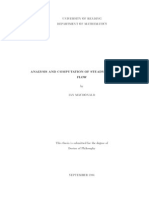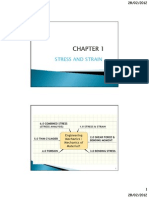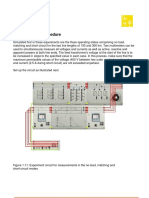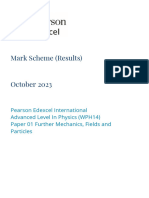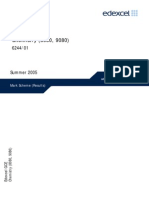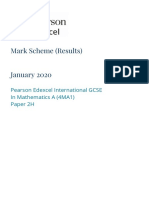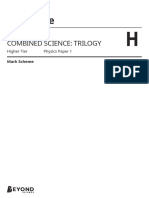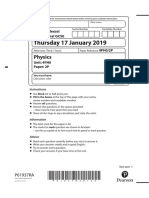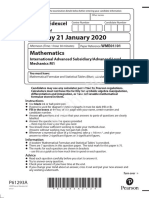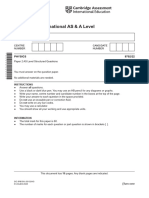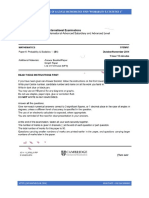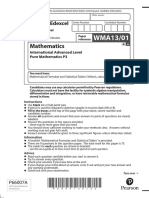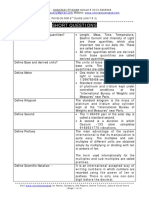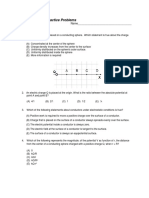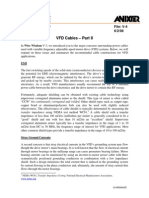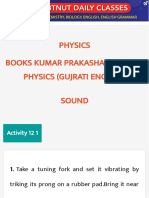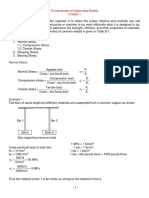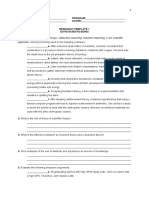Mark Scheme (Results) Summer 2023: Pearson Edexcel GCE in Physics (9PH0) Paper 01: Advanced Physics I
Uploaded by
AhippoMark Scheme (Results) Summer 2023: Pearson Edexcel GCE in Physics (9PH0) Paper 01: Advanced Physics I
Uploaded by
AhippoMark Scheme (Results)
Summer 2023
Pearson Edexcel GCE
In Physics (9PH0)
Paper 01: Advanced Physics I
Edexcel and BTEC Qualifications
Edexcel and BTEC qualifications come from Pearson, the world’s leading
learning company. We provide a wide range of qualifications including
academic, vocational, occupational and specific programmes for employers.
For further information visit our qualifications websites at www.edexcel.com
or www.btec.co.uk for our BTEC qualifications.
Alternatively, you can get in touch with us using the details on our contact us
page at www.edexcel.com/contactus.
If you have any subject specific questions about this specification that require
the help of a subject specialist, you can speak directly to the subject team at
Pearson.
Their contact details can be found on this link:
www.edexcel.com/teachingservices.
You can also use our online Ask the Expert service at www.edexcel.com/ask.
You will need an Edexcel username and password to access this service.
Pearson: helping people progress, everywhere
Our aim is to help everyone progress in their lives through education. We
believe in every kind of learning, for all kinds of people, wherever they are in
the world. We’ve been involved in education for over 150 years, and by
working across 70 countries, in 100 languages, we have built an international
reputation for our commitment to high standards and raising achievement
through innovation in education. Find out more about how we can help you
and your students at: www.pearson.com/uk
Summer 2023
Question Paper Log Number P71915A
Publications Code 9PH0_01_2306_MS
All the material in this publication is copyright
© Pearson Education Ltd 2023
General Marking Guidance
• All candidates must receive the same treatment. Examiners must
mark the first candidate in exactly the same way as they mark the
last.
• Mark schemes should be applied positively. Candidates must be
rewarded for what they have shown they can do rather than
penalised for omissions.
• Examiners should mark according to the mark scheme not according
to their perception of where the grade boundaries may lie.
• There is no ceiling on achievement. All marks on the mark scheme
should be used appropriately.
• All the marks on the mark scheme are designed to be awarded.
Examiners should always award full marks if deserved, i.e. if the
answer matches the mark scheme. Examiners should also be
prepared to award zero marks if the candidate’s response is not
worthy of credit according to the mark scheme.
• Where some judgement is required, mark schemes will provide the
principles by which marks will be awarded and exemplification may
be limited.
• When examiners are in doubt regarding the application of the mark
scheme to a candidate’s response, the team leader must be
consulted.
• Crossed out work should be marked UNLESS the candidate has
replaced it with an alternative response.
Mark scheme notes
Underlying principle
The mark scheme will clearly indicate the concept that is being rewarded,
backed up by examples. It is not a set of model answers.
1. Mark scheme format
1.1 You will not see ‘wtte’ (words to that effect). Alternative correct wording
should be credited in every answer unless the MS has specified specific
words that must be present. Such words will be indicated by underlining e.g.
‘resonance’
1.2 Bold lower case will be used for emphasis e.g. ‘and’ when two pieces of
information are needed for 1 mark.
1.3 Round brackets ( ) indicate words that are not essential e.g. “(hence)
distance is increased”.
1.4 Square brackets [ ] indicate advice to examiners or examples e.g. [Do not
accept gravity] [ecf].
2. Unit error penalties
2.1 A separate mark is not usually given for a unit but a missing or incorrect
unit will normally mean that the final calculation mark will not be awarded.
2.2 This does not apply in ‘show that’ questions or in any other question
where the units to be used have been given, for example in a spreadsheet.
2.3 The mark will not be awarded for the same missing or incorrect unit only
once within one clip in epen.
2.4 Occasionally, it may be decided not to insist on a unit e.g the candidate
may be calculating the gradient of a graph, resulting in a unit that is not one
that should be known and is complex.
2.5 The mark scheme will indicate if no unit error is to be applied by means of
[no ue].
3. Significant figures
3.1 Use of too many significant figures in the theory questions will not be
prevent a mark being awarded if the answer given rounds to the answer in
the MS.
3.2 Too few significant figures will mean that the final mark cannot be
awarded in ‘show that’ questions where one more significant figure than the
value in the question is needed for the candidate to demonstrate the validity
of the given answer.
3.3 The use of one significant figure might be inappropriate in the context of
the question e.g. reading a value off a graph. If this is the case, there will be a
clear indication in the MS.
3.4 The use of g = 10 m s-2 or 10 N kg-1 instead of 9.81 m s-2 or 9.81 N kg-1 will
mean that one mark will not be awarded. (but not more than once per clip).
Accept 9.8 m s-2 or 9.8 N kg-1
3.5 In questions assessing practical skills, a specific number of significant
figures will be required e.g. determining a constant from the gradient of a
graph or in uncertainty calculations. The MS will clearly identify the number
of significant figures required.
4. Calculations
4.1 Bald (i.e. no working shown) correct answers score full marks unless in a
‘show that’ question.
4.2 If a ‘show that’ question is worth 2 marks. then both marks will be
available for a reverse working; if it is worth 3 marks then only 2 will be
available.
4.3 use of the formula means that the candidate demonstrates substitution
of physically correct values, although there may be conversion errors e.g.
power of 10 error.
4.4 recall of the correct formula will be awarded when the formula is seen or
implied by substitution.
4.5 The mark scheme will show a correctly worked answer for illustration
only.
Question
Acceptable answers Additional guidance Mark
Number
1 The only correct answer is C 1
A is not the correct answer, as there are 8 protons and 9 neutrons.
B is not the correct answer, as there are 8 protons and 9
neutrons.
D is not the correct answer, , as there are 8 protons and 9 neutrons.
2 The only correct answer is C 1
A is not the correct answer, as a baryon has three quarks.
B is not the correct answer, as leptons are fundamental particles
D is not the correct answer, as a nucleon is a proton or neutron
3 The only correct answer is D 1
𝑡 1
A is not the correct answer, as − 𝑇 = ln 2
𝑡 1
B is not the correct answer, as − 𝑇 = ln 2
𝑡 1
C is not the correct answer, as − 𝑇 = ln 2
4 The only correct answer is A 1
B is not the correct answer, as both mass and lifetime both increase.
C is not the correct answer, as both mass and lifetime both increase.
D is not the correct answer, as both mass and lifetime both increase.
5 The only correct answer is D 1
A is not the correct answer, as centripetal force keeps car moving
with circular motion
B is not the correct answer, as centripetal force keeps car moving
with circular motion
C is not the correct answer, as this would keep car moving with
circular motion
6 The only correct answer is D 1
A is not the correct answer, as efficiency = useful output/input =
40/44
B is not the correct answer, as efficiency = useful output/input =
40/44
C is not the correct answer, as efficiency = useful output/input =
40/44
7 The only correct answer is D 1
A is not the correct answer, as change in momentum is the same.
B is not the correct answer, as change in velocity is the same.
C is not the correct answer, as force decreases.
8 The only correct answer is C 1
A is not the correct answer, as P,E. increases and speed decreases as
particle approaches nucleus
B is not the correct answer, as P,E. increases and speed decreases as
particle approaches nucleus
D is not the correct answer, as P,E. increases and speed decreases as
particle approaches nucleus
9 The only correct answer is D 1
A is not the correct answer, as electrons will not deflect particle.
B is not the correct answer, as neutral atom will not deflect particle.
C is not the correct answer, as this cannot be concluded from
observing just one particle.
10 The only correct answer is B 1
A is not the correct answer, as the gradient of the velocity graph
must increase.
C is not the correct answer, as the gradient of the velocity graph
must increase.
D is not the correct answer, as as the gradient of the velocity graph
must increase.
(Total for Multiple Choice Questions = 10 marks)
Question
Acceptable answers Additional guidance Mark
Number
11(a) An explanation that makes reference to the following points: (1) 4
• current (in coil) produces a magnetic field/flux
• (a.c.) leads to changing (magnetic) field/flux through pan (1) MP2 – 4 must relate to the pan
• induces an emf in pan (1)
• leads to current (in pan because it is an electrical conductor) (1)
MP4 dependent on MP2
11(b) An explanation that makes reference to the following points: 2
• high frequency means that flux/field is changing quickly
Or increases rate of change of flux/field
(1)
• leads to increased (induced) emf (in pan)
Or leads to increase in (induced) current (in pan)
MP2 dependent on MP1 (1)
(Total for Question 11 = 6 marks)
Question
Acceptable answers Additional guidance Mark
Number
12(a) • A vector has magnitude and direction (1) 1
12(b) An explanation that makes reference to the following points: 2
1 (1)
• States I = nqvA Or n and q stated as constant Or 𝑣 ∝ 𝐴
• v must increase (if A decreases) (1)
MP2 dependent on MP1
12(c) Either 4
• j has units A m−2 (1)
•
E has units V m−1 or N C−1 (1) 𝐸 Vm-1
Example: Units of 𝑗 = Am-2 = Ωm and these are the units
(1) of 𝜌
• has units of m
(1) Or find agreements for both sides using options shown
• Algebra to show units the same on both sides below:
𝐸 N C-1 Nm2 Jm kgms -2 m2 kgm3 s -3
Or Units of are = = AC = =
𝐽 Am-2 AC A2 s A2
If formulas have been used:
(1)
V Nm2 Jm
• Substitution using 𝜌 = 𝑅𝐴/𝑙 Units of 𝜌 = Ωm= m= =
(1) A CA CA
kgms -2 m2 kgm3 s-3
• Substitution using E = V/d = =
(1) A2 s A2
• Substitution using R = V/I
(1)
• The equations above and j = I/A need to be rearranged and
simplified with (or R) appearing on either side
(Total for Question 12 = 7 marks)
Question
Acceptable answers Additional guidance Mark
Number
13(a) • 30 lux corresponds to 3000 (1) Example of calculation 6
• Use of ratio of resistances (1) 𝑉 333
=
7.0 333 + 3000
• Use of corresponding ratio of p.d.s (1)
• To a p.d. of 0.7 (V) (1) V = 0.70 V
• if light goes above this level then resistance of LDR Alternative for MP2 and MP3
decreases (1) • Use of I = V/R for whole circuit
• so p.d. to transistor increases so does perform as required • Use of V = IR for 333 resistor
(1)
MP6 dependent on MP5 Example of calculation
I = 7.0 V/ (333 + 3 × 103 )
= 2.1 × 10−3 A
V = 2.1 × 10−3 A ×333
= V
13(b) An explanation that makes reference to the following points: 2
• more electrons move into a conduction band
Or more electrons become free (1)
• with (increased light level) so resistance decreases (1)
MP2 dependent on MP1
(Total for Question 13 = 8 marks)
Question
Acceptable answers Additional guidance Mark
Number
14(a)(i) • Attempt to take moments around right hand end of X (1) distance of 1.5 m used with 45 Or 1.3 m used with T 4
• Use of W = mg (1)
Example of calculation
• Correct component of T or perpendicular distance to T (1)
45 kg × 9.81 N kg −1 × 1.5 m = 𝑇 × 1.3 m × sin35
• T = 890 N (1)
T = 888 N
14(a)(ii) • (thrust) arrow approx 35o to horizontal to the upper left (1) 2
• arrow direction capable of balancing opposite pair (1) Do not penalise whether force from column is
above/below/on the horizontal
Force from rod Y
Force from
column
14(b) • Use of 𝐸 =
constant (1) eg writes Q = 4πε0Er2 Or Q/4πε0 = Er2 Or Er2 = k 3
𝑟2
(1) Example of calculation
• Calculates at least one value of the constant
1200 N C-1 ×32 m2= 10800 V m
100 N C-1 ×252 m2= 62500 V m
• Calculates a second value and states that the field is not (1) Or
inverse square law 1200 N C-1 ×32 m2×4πε0= 1.2 ×10-6 C
100 N C-1 ×252 m2×4πε0= 6.9 ×10-6 C
Or
1200 N C-1 ×32 m2= 10800 V m
10800 V m
= 108 m2 and √108 = 10.4 not 25
100 N C -1
(Total for Question 14 = 9 marks)
Question
Acceptable answers Additional guidance Mark
Number
15(a)(i) • Leaves no track (1) 1
Or the tracks present are opposite curvatures
15(a)(ii) • proton is positive (1) both marks can be given for 0 = +1 -1 with pion identified 2
as negative.
• conservation of charge means pion is negative (1)
Or opposite curvature to proton means pion is negative
15(a)(iii) • () → p(+) + − (1) Allow ecf if pion was stated as positive in (ii) 1
15(a)(iv) • baryon number conserved 1
Or baryon number is +1 on both sides of equation
Or proton is baryon and the pion is not a baryon (1)
15(a)(v) An explanation that makes reference to the following 3
points:
• The radius of the proton path is (very) large (compared Allow proton path is less curved
with the pion) (1)
• According to p = BQr (1) Allow 𝑝 ∝ 𝑟
• The momentum of the proton is larger than the
momentum of the pion. (dependent on MP2 or MP1) (1)
15(b)(i) • Converts eV to J (1) Example of calculation 3
1232 V × 1.6 × 10−19 C × 106
• use of m = E / c2 (1) 𝑚=
(3 × 108 )2 (ms−1 )2
𝑚 = 2.19 × 10−27 kg
• mass = 2.19 × 10-27 (kg) (1)
15(b)(ii) • Calculates mass difference 3
Or states (total) mass of decay products is less than mass of Example of Calculation
delta particle (1) 939 + 139 = 1078
1232 – 1078 = 154(MeV/c2)
• According to ∆𝐸 = ∆𝑚𝑐 2 (1) Or
1232 is more than 1078(MeV/c2)
• becomes (extra) Ek (between decay products) (1)
(Total for Question 15 = 14 marks)
Question
Acceptable answers Additional guidance Mark
Number
*16(a)
This question assesses a student’s ability to show a coherent Max
and logically structured answer with linkages and fully- linkage Max final
sustained reasoning. IC points IC mark
mark mark
Marks are awarded for indicative content and for how the available
answer is structured and shows lines of reasoning. 6 4 2 6
The following table shows how the marks should be awarded 5 3 2 5
for indicative content. 4 3 1 4
3 2 1 3
2 2 0 2
1 1 0 1
Indicative content:
0 0 0 0
• Current direction is D to C in coil
Or Current direction is B to A (1) Arrows could be added to the diagram 6
• There is a force due to current (carrying conductor) within a
(1) Accept F=BIl
magnetic field
• The force is vertically down on side DC allow ecf if current direction is defined/indicated in the
(1) opposite direction
Or The force is vertically up on side BA
• Moment of force (around axis) produces rotation (in an (1)
anticlockwise direction)
• as coil moves through half a turn split ring ensures the (1)
current switches direction (for a particular side)
• This results in the coil continuing to rotate (in the same (1)
direction)
16(b) • Use of P = W/t (1) Example of calculation 3
Work done by motor = 390 ×103 W × 4.0 s = 1.56 ×106 J
• Use of Ek = ½ mv2 (1)
Or use of SUVAT, F = ma and W=Fs Ek = ½ 1950 kg × 282 (m s−1)2 = 764400 J
• Work done = 8.0 ×105 J Work done by resistive forces =1.56 ×106 J −764400 =
(1) 795600 J
Second example of MP2
28 m s-1 -0
𝑎= =7.0 m s-2
4.0 s
Resultant force = 1950 kg×7.0m s -2 =13650 N
0+28 m s−1
𝑠= 2
× 4.0 s = 56 m
Work to increase velocity = 13650 N × 56 m
= 764400 J
Work done by resistive forces = 1.56 ×106 J −764400 =
795600 J
16(c) An explanation that makes reference to the following points: 3
Energy Argument:
• More energy transferred in the battery (rather than the (1) Accept reference to heating effect in the battery
motor)
• The battery/car will be less efficient (1)
• Therefore the battery will need charging more often Or (1)
journey will be shorter
Force/Power Argument:
• Increased internal resistance reduces terminal p.d.
(1)
• reduces the current (in the circuit)
(1)
• So acceleration of car is reduced Or less power Or
battery will take longer to charge (1)
(Total for Question 16 = 12 marks)
Question
Acceptable answers Additional guidance Mark
Number
17(a) Example of calculation 5
• Uses correct components of velocity (1) Initial vertical component velocity = 23.8 sin50
= 18.23 m s-1
• Uses v = d/t in the horizontal plane Or Uses any equation of (1) Horizontal component velocity = 23.8 cos50
motion in the horizontal plane = 15.30 m s-1
(1)
• Uses s = ut + ½ at 2 t = 55.0 m / 15.30 m s-1 = 3.595 s
(1) 9.81 m s -2 × 3.5952 s 2
• the ut term has the opposite sign to the term at2 𝑠 = 18.23m s-1 × 3.595 s −
2
(1)
• s = 2.1 m so fielder can catch the ball because it is less than s = 65.5 m – 63.4 m = 2.1 m
3m
Or starts the same with vH and vV
(allow rounding error in final answer)
9.81 m s-2 × 𝑡 2
3.0 m = 18.23m s -1 × 𝑡 −
2
t = 3.54 s
s = 15.30 m s-1×3.54 s = 54.2 m
So at s = 55 m the ball will be below 3 m and can be
caught
17(b)(i) Example of calculation 1
• p = 3.33 (N s) (1) 𝑝 = 0.140 kg × 23.8 m s-1
p = 3.33 kg m s−1
17(b)(ii) • Draws labelled vector line with a ruler representing pball after (1) Accept a label such as “ball after” 5
• at approximately the correct angle (50o) (1)
• length of line scaled correctly Or recognises the scale is 1 (1) ie length of pball after should be about 3(.3) cm
cm = 1 N s
• either p ball after line or p bat after line should start at the start of (1) This can only be given if there is a correct arrow and
the p ball before line. either label
(1)
• o
Momentum = 8.3 (N s) ∓ 0.3 and angle = 34 ∓ 3 o
Or
(Total for Question 17 = 11 marks)
Question
Acceptable answers Additional guidance Mark
Number
18(a)(i) • Vrms = 3.5 V (1) Example of calculation 1
5
𝑉rms = 2 =3.54 V
√
18(a)(ii) An explanation that makes reference to the following points: 3
• “5” is the peak value (of pd) (1) Accept max for peak
• Use of T = 1/f Or = 2π/ Or 𝜔 = 2𝜋𝑓 (1) Alternative MP2: recognises that one period/cycle of the
sine wave is an angle of 2π
• Uses = 100π to show that the time period should be 0.02 s
Or Uses f = 50 to show that sin 2𝜋𝑓𝑡 is sin 100𝜋 𝑡 (1)
Or Uses T = 0.02 to show that 100π0.02 = 2π
18(b)(i) • Q = CV Or E10 = C10 * C (1) 2
• where C = 0.001 (F) (1)
MP2 dependent on MP1
18(b)(ii) • I = Q / t Or G11 = F11 / B11 (1) 1
18(b)(iii) 1 1 𝑄2 (1) Example of calculation 2
• Use of 𝑊 = 2 𝐶𝑉 2 Or W = ½ QV Or 𝑊 = 2 𝐶 1
𝑊 = 2 0.001 F × 52 V 2 = 0.0125 J
(1) 1
• W = 0.0125 J 𝑊 = 2 0.005C×5V =0.0125 J
18(c) • States P = IV (1) Graph could be marked with values/lines/power curve 4
• any two corresponding values of I and V used to calculate a (1) Alternative MP2: recognise the symmetry of either
value of P quarter or half cycles of the graphs
• observation that at different times P is negative or positive (1)
• Overall power dissipated by capacitor is zero (1)
(Total for Question 18 = 13 marks)
Pearson Education Limited. Registered company number 872828
with its registered office at 80 Strand, London, WC2R 0RL, United Kingdom
You might also like
- Mark Scheme (Results) : Pearson Edexcel International Advanced Subsidiary/Advanced Level in Pure Mathematics P4 (WMA14/01)No ratings yetMark Scheme (Results) : Pearson Edexcel International Advanced Subsidiary/Advanced Level in Pure Mathematics P4 (WMA14/01)19 pages
- EdExcel A Level Chemistry Unit 4 Mark Scheme Results Paper 1 Jun 2005No ratings yetEdExcel A Level Chemistry Unit 4 Mark Scheme Results Paper 1 Jun 200510 pages
- October 2017 (IAL) QP - Unit 1 Edexcel Physics A-LevelNo ratings yetOctober 2017 (IAL) QP - Unit 1 Edexcel Physics A-Level28 pages
- Mark Scheme (Results) January 2020: Pearson Edexcel International GCSE in Mathematics A (4MA1) Paper 2HNo ratings yetMark Scheme (Results) January 2020: Pearson Edexcel International GCSE in Mathematics A (4MA1) Paper 2H28 pages
- 01a 1MA1 1F November 2019 Examination Paper PDF100% (1)01a 1MA1 1F November 2019 Examination Paper PDF20 pages
- Mark Scheme (Results) Summer 2019: Pearson Edexcel GCE Further Mathematics Further Pure 1 Paper 6667 - 01No ratings yetMark Scheme (Results) Summer 2019: Pearson Edexcel GCE Further Mathematics Further Pure 1 Paper 6667 - 0119 pages
- June 2019 (IAL) MS - Unit 4 Edexcel Chemistry A-LevelNo ratings yetJune 2019 (IAL) MS - Unit 4 Edexcel Chemistry A-Level34 pages
- Topic Test Oxfordaqa International Gcse Physics 9203 Energy100% (1)Topic Test Oxfordaqa International Gcse Physics 9203 Energy17 pages
- AQA GCSE Combined Science Physics Paper 1 Higher Mark SchemeNo ratings yetAQA GCSE Combined Science Physics Paper 1 Higher Mark Scheme12 pages
- Cambridge International AS & A Level: PHYSICS 9702/34No ratings yetCambridge International AS & A Level: PHYSICS 9702/3412 pages
- Short Questions: Physics For 9 Class (Unit # 2)No ratings yetShort Questions: Physics For 9 Class (Unit # 2)4 pages
- WWW Slideshare Net Mobile Daniholic Earth Science Teaching Guide100% (1)WWW Slideshare Net Mobile Daniholic Earth Science Teaching Guide29 pages
- Republic of The Philippines Professional Regulation Commission Manila100% (1)Republic of The Philippines Professional Regulation Commission Manila36 pages
- Ap Phys1 - Electric Potential Practice Problems - 2015 02 28No ratings yetAp Phys1 - Electric Potential Practice Problems - 2015 02 2822 pages
- Tangential and Normal Components of Acceleration - Suggested Problems - SolutionsNo ratings yetTangential and Normal Components of Acceleration - Suggested Problems - Solutions7 pages
- PDF Combinatorial Physics: Combinatorics, Quantum Field Theory, and Quantum Gravity Models Adrian Tanasa download100% (2)PDF Combinatorial Physics: Combinatorics, Quantum Field Theory, and Quantum Gravity Models Adrian Tanasa download41 pages
- Observation of The Non-Hermitian Skin Effect and Fermi Skin On A Digital Quantum ComputerNo ratings yetObservation of The Non-Hermitian Skin Effect and Fermi Skin On A Digital Quantum Computer25 pages
- Advanced Inorganic Chemistry - ROBERT L. CARTERNo ratings yetAdvanced Inorganic Chemistry - ROBERT L. CARTER19 pages
- Simple Stress: Fundamentals of Deformable BodiesNo ratings yetSimple Stress: Fundamentals of Deformable Bodies3 pages
- Geophysics Two Marks Question and Answers 1. List Out The Elements Present in The Inner Core of The Earth100% (1)Geophysics Two Marks Question and Answers 1. List Out The Elements Present in The Inner Core of The Earth9 pages
- 18.physical Science English Medium Modal Paper - 2No ratings yet18.physical Science English Medium Modal Paper - 24 pages
- UT,+TE+&+AIATS+FS+Planner Session+2024-25 Phase-01+for+studentsNo ratings yetUT,+TE+&+AIATS+FS+Planner Session+2024-25 Phase-01+for+students2 pages









